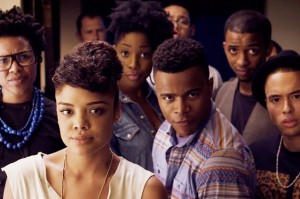The Breakfast Club — 30 Years Later
Posted on February 20, 2015 at 3:43 pm

“The Breakfast Club,” is one of the best of the John Hughes films about teenagers. No American filmmaker portrayed the lives of contemporary teenagers with as much affection, sensitivity, and understanding as Hughes, with Molly Ringwald the very best of his favorite group of actors. In The Breakfast Club, five high school kids spend a Saturday in detention. In the highly stratified world of high school, each of them is in a different group and no other circumstance would bring them together. There is the popular girl (Ringwald), the rebel (Judd Nelson), the jock (Emilio Estevez), the nerd (Anthony Michael Hall), and the loner (Ally Sheedy). Forced to spend time in the same room, they argue, insult each other, and then confide in each other more honestly than they could feel comfortable doing with the people they think of as part of their group of friends. It has become such a classic that it played a crucial part in the recent hit “Pitch Perfect.” The cast of “Glee” paid tribute as well. And the movie is referred to in the opening moments of today’s new high school movie, “The DUFF.”
Molly Ringwald talked to Time Magazine about her thoughts three decades later.
There really hasn’t been anything to replace it. It’s kind of a classic because it all takes place in the one day, so there’s just one wardrobe. There were less chances for it to look incredibly dated. The theme is something that is still really relevant today, which is that no matter who you are, no matter where you come from, everyone kind of feels the same, which is that they don’t belong. And that’s a sort of powerful theme.
On the other hand, she notes, if the breakfast club met today, the kids would not talk to each other. They would be too busy texting.
E! has a list of “Breakfast Club” quotes that still ring true today. And critic Christy Lemire revisited the film and found it held up pretty well, even though she now sees it as a critic and a mother, rather than a contemporary of the characters.
I’m happy to report that, three decades later, “The Breakfast Club” remains timeless. It still reflects the narcissistic torment of teen angst: the feeling that nobody understands what you’re going through (certainly not your parents) and that your troubles are all-encompassing and insurmountable. It’s still consistently funny and endlessly quotable. Hughes had an unparalleled knack for writing teenagers — hyper-verbal characters full of self-aware, sharp humor who were also capable of making themselves vulnerable and revealing their hearts. It’s paced beautifully and moves seamlessly in tone from light moments to heavier ones.



